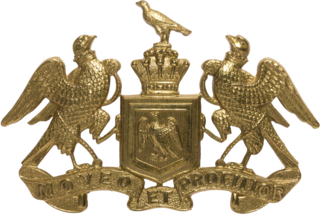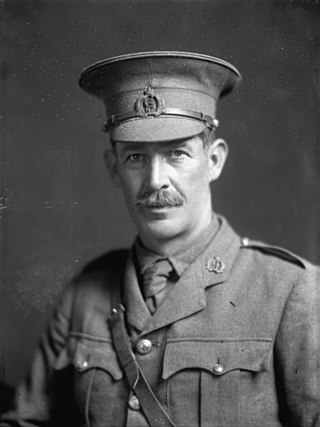
The New Zealand Expeditionary Force (NZEF) was the title of the military forces sent from New Zealand to fight alongside other British Empire and Dominion troops during World War I (1914–1918) and World War II (1939–1945). Ultimately, the NZEF of World War I became known as the First New Zealand Expeditionary Force. The NZEF of World War II was known as the Second New Zealand Expeditionary Force (2NZEF).

Queen Alexandra's Mounted Rifles (QAMR) is an armoured regiment of the New Zealand Army and forms part of the Royal New Zealand Armoured Corps. The regiment was formed in 1864 and is currently an armoured cavalry unit equipped with NZLAV.

The New Zealand Mounted Rifles Brigade was a brigade of the New Zealand Army during the First World War. Raised in 1914 as part of the New Zealand Expeditionary Force, it was one of the first New Zealand units to sail for service overseas.
The Waikato Mounted Rifles (WMR) is the New Zealand Army's only Territorial Force squadron of the Royal New Zealand Armoured Corps (RNZAC). The Squadron's origins can be traced back to 1869 when the first mounted unit was raised in the Waikato. Today the Squadron is part of Queen Alexandra's Mounted Rifles (QAMR) where it forms the regiment's reserve squadron. WMR's role is mounted reconnaissance and surveillance.
The Wellington West Coast and Taranaki Regiment was a Territorial Force unit of the New Zealand Army. It was originally formed in 1948 by the amalgamation of two separate regiments:

The 1st Mounted Rifles (Canterbury Yeomanry Cavalry) were a mounted rifles regiment raised just before World War I, raised and based in the region of Canterbury. It can trace its history back to 1864 with the formation of the Canterbury Yeomanry Cavalry.

The 3rd (Auckland) Mounted Rifles was formed on March 17, 1911. They were mobilised during the First World War as a squadron of the Auckland Mounted Rifles Regiment. They served in the Middle Eastern theatre of World War I and first saw action during the Battle of Gallipoli. As a part of the larger New Zealand Mounted Rifles Brigade they went on to serve in the Sinai and Palestine Campaign.

The 8th Mounted Rifles was formed on March 17, 1911. They were mobilised during World War I as a squadron of the Canterbury Mounted Rifles Regiment. They served in the Middle Eastern theatre of World War I and first saw action during the Battle of Gallipoli. As a part of the larger New Zealand Mounted Rifles Brigade they went on to serve in the Sinai and Palestine Campaign.

The 9th Mounted Rifles Regiment was officially raised on March 17, 1911. It was one of 12 regionally based mounted rifles regiments formed as part of the new Territorial Force (TF) organisation that came into existence on that day. This part-time Territorial Force and a tiny regular force of professional soldiers formed the basis of New Zealand’s army at the outbreak of the First World War.

The 10th (Nelson) Mounted Rifles, previously known as the 1st Regiment, Nelson Mounted Rifles was a military unit based in Nelson, New Zealand. They served in the Middle Eastern theatre of World War I and first saw action during the Battle of Gallipoli. As a part of the larger New Zealand Mounted Rifles Brigade they went on to serve in the Sinai and Palestine Campaign.

The 11th Mounted Rifles was formed on 17 March 1911. They were mobilised during World War I as a squadron of the Auckland Mounted Rifles Regiment. They served in the Middle Eastern theatre of World War I and first saw action during the Battle of Gallipoli. As a part of the larger New Zealand Mounted Rifles Brigade they went on to serve in the Sinai and Palestine campaign.

The Canterbury Mounted Rifles Regiment was a mounted infantry regiment from New Zealand, raised for service during the First World War. It was assigned to the New Zealand Mounted Rifles Brigade, and formed part of the New Zealand Expeditionary Force.

The Wellington Mounted Rifles Regiment was a mounted infantry regiment from New Zealand, raised for service during the First World War. It was assigned to the New Zealand Mounted Rifles Brigade, part of the New Zealand Expeditionary Force.

The 4th Light Horse Regiment was a mounted infantry regiment of the Australian Army during the First World War. The regiment was raised in August 1914, as the divisional cavalry regiment for the 1st Division. The regiment fought against the forces of the German Empire and the Ottoman Empire, in Egypt, at Gallipoli, on the Western front, on the Sinai Peninsula, and in Palestine and Jordan. After the armistice the regiment eventually returned to Australia in March 1919. For its role in the war the regiment was awarded twenty-one battle honours.

Brigadier General William Meldrum was a New Zealand lawyer, farmer, military leader, magistrate and local politician.

Major Norman Frederick Hastings, DSO served as Officer Commanding New Zealand's 6th (Manawatu) Squadron, Wellington Mounted Rifles Regiment. After serving with British military units during the Second Anglo-Boer War in South Africa, he worked as an engineering fitter with the New Zealand Railways Department workshops at Petone. He enlisted in the New Zealand Expeditionary Force at the outbreak of World War I, and served with distinction before dying of wounds after the attack on Chunuk Bair, Gallipoli, in August 1915. He was awarded the Distinguished Service Order, was Mentioned in Despatches, and was one of only 14 members of the New Zealand Army to receive the French Legion of Honour decoration during the war. The memorial flagstaff at Petone railway station appears to have been erected in his honour, and was the site of New Zealand's first public Anzac Day ceremony on 25 April 1916.

The Battle of Ayun Kara was an engagement in the Sinai and Palestine Campaign during the First World War. The battle was fought between the New Zealand Mounted Rifles Brigade and a similar-sized rearguard from the Turkish 3rd Infantry Division, which was part of the XXII Corps of the Ottoman Eighth Army under Kress von Kressenstein.

The 1st Machine Gun Squadron was a sub-unit of the New Zealand Military Forces during the First World War. It was part of the New Zealand Mounted Rifles Brigade, and served with them in the Sinai and Palestine Campaign from 1916 to 1918.

The battle for No.3 Post was fought during the Gallipoli Campaign in the First World War, between the forces of the New Zealand Mounted Rifles Brigade and the Turkish 19th Division.

The Hawke's Bay Regiment was a territorial infantry regiment of the New Zealand Military Forces. The regiment traced its origins to the Napier Rifle Volunteer Rifles, a volunteer corps formed in 1863 and which would later amalgamate with other volunteer corps to form the 9th Regiment in 1911. During the First World War, the regiment provided a company to each of the battalions of the Wellington Infantry Regiment and saw combat at Galipolli and on the Western Front. After the war the regiment was renamed the Hawke's Bay Regiment and remained in New Zealand for home defense during the Second World War. Men from the regiment, however, served with the 19th, 22nd, 25th and 36th Battalions of the Second New Zealand Expeditionary Force. The regiment had a close relationship with the Ruahine Regiment, which was detached and reabsorbed by the Hawke's Bay regiment on two separate occasions. In 1964, the Hawkes Bay regiment was amalgamated with the Wellington Regiment and become the 7th Battalion, Royal New Zealand Infantry Regiment



















